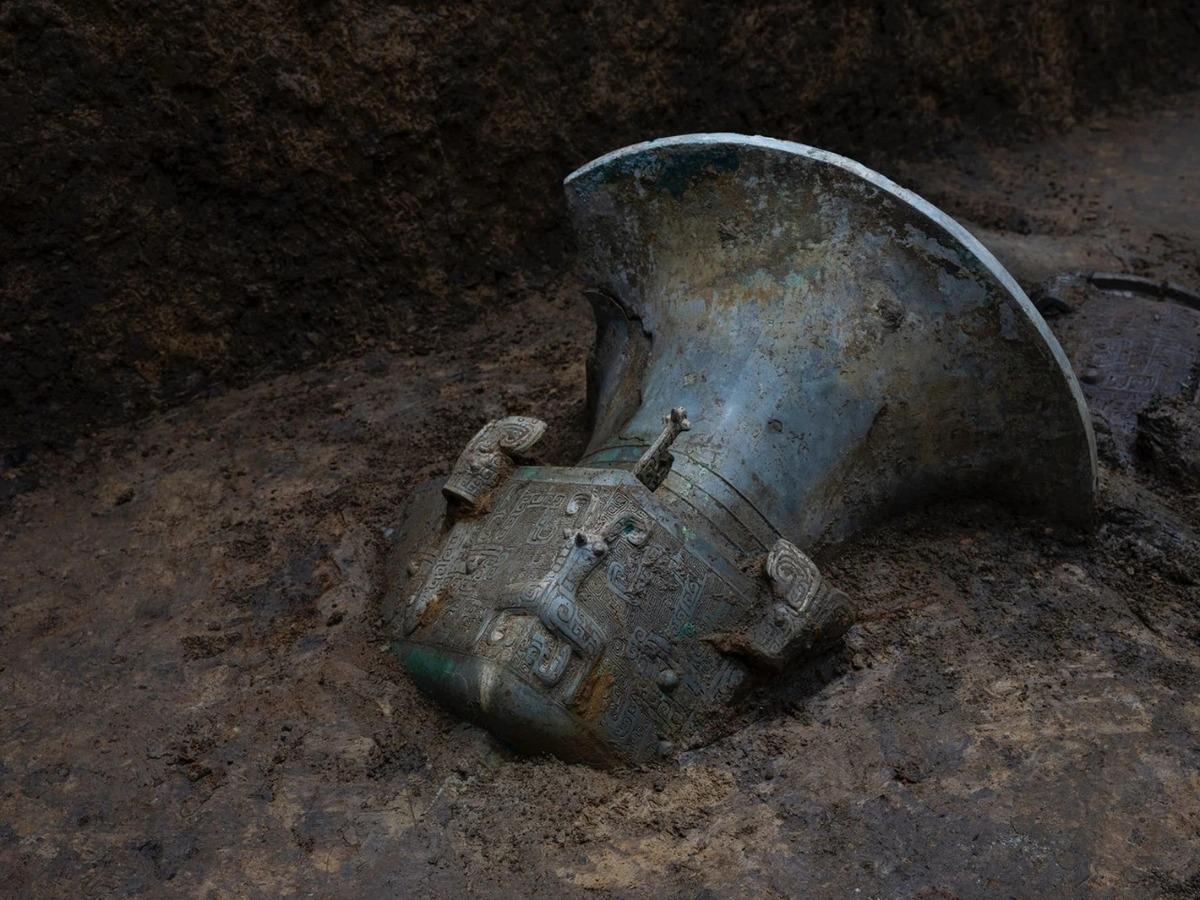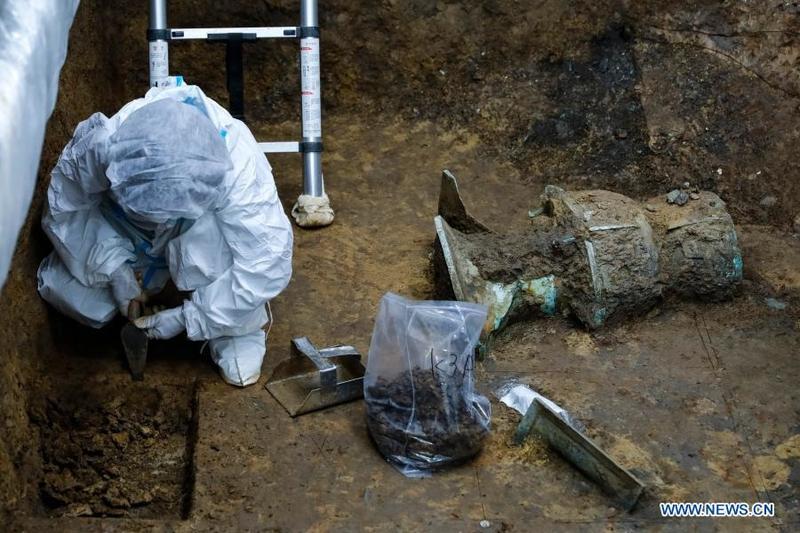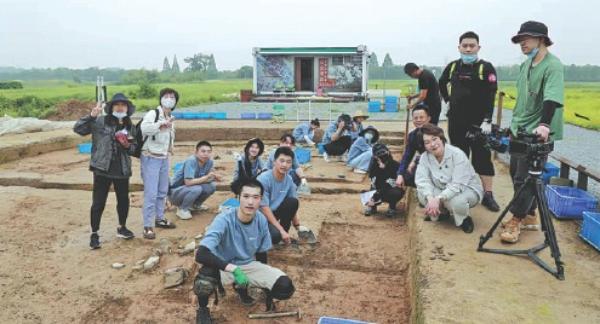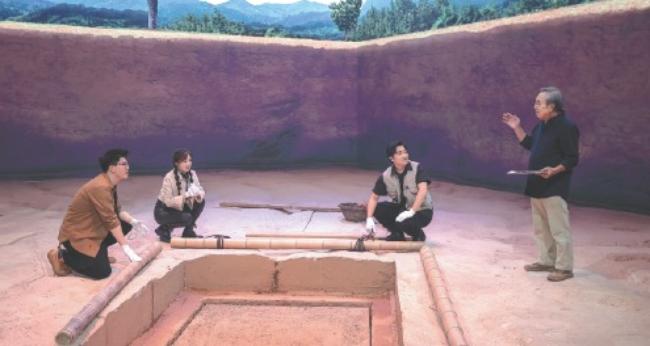 A rare type of bronze vessel zun, which has a round rim and a square body, is among the items newly unearthed from Sanxingdui site. (PHOTO PROVIDED TO CHINA DAILY)
A rare type of bronze vessel zun, which has a round rim and a square body, is among the items newly unearthed from Sanxingdui site. (PHOTO PROVIDED TO CHINA DAILY)
The discovery of thousands of cultural relics at the Sanxingdui site in Guanghan, Sichuan province, was probably this year's biggest archaeological surprise in China.
An aura of mystery has shrouded this 3,000-year-old site since myriad exotic bronze masks, believed to have been used for sacrificial rituals, were unearthed from two pits in 1986.
While offering clues to the belief system, social structure and communication with other cultures, the excavation of six other pits at Sanxingdui this year has triggered even more questions about the past, archaeologists said.
Masks-many more than previously seen among this type of bronze ware-exquisite jade artifacts, silk remnants and many other examples of rare relics were discovered in a new round of excavations.
The public has begun to understand our working process and has a better idea of how artifacts are unearthed. People only need a key finding like that at Sanxingdui to become more familiar with archaeology. It's great that we can find ways that are easily accepted by more people to explain our achievements.
Xu Danyang, member of the Sichuan Provincial Cultural Relics and Archaeology Research Institute
Public interest in the excavations, which are ongoing, was triggered by two livestream broadcasts from the six pits by China Central Television in March and September.
Numerous related short video clips went viral and virtual reality technology was used by newsrooms to explain the findings. Animated illustrations and other platforms featuring Sanxingdui led to the site becoming a major cultural attraction this year.
For example, on Sina Weibo, Sanxingdui appeared in 16 trending topics within five days in September-five of them viewed more than 100 million times on the platform.
Xu Danyang, 26, joined the Sichuan Provincial Cultural Relics and Archaeology Research Institute after graduating from Peking University last year. A member of the archaeological team working at Sanxingdui, he was surprised to learn he had been interviewed by more than 80 media platforms this year.
"At first, I wondered why they wanted to interview me. After all, I'm just a young and ordinary archaeologist. But I later found that people now prefer to learn about archaeological findings from younger people.
"The public has begun to understand our working process and has a better idea of how artifacts are unearthed. People only need a key finding like that at Sanxingdui to become more familiar with archaeology. It's great that we can find ways that are easily accepted by more people to explain our achievements."
This year marks the centenary of the birth of modern Chinese archaeology. In 1921, the Yangshao site, which is about 5,000 years old, was found in what is now Sanmenxia, Henan province. The discovery not only revealed a stunning collection of painted pottery, but also created the foundations to study the Neolithic period in China.
Chinese archaeologists have unveiled the country's past, even in times of war, social unrest, and most recently, the COVID-19 pandemic.
When archaeology is mixed with popular science, people find it more interesting. Having an open mind is key to promoting archaeology among the public, and archaeologists need to unveil their latest findings promptly.
Ran Honglin, leading archaeologist at the Sanxingdui site
Last year, more than 1,300 archaeological excavations were made in China, the most to date.
ALSO READ: New finds at Sanxingdui Ruins shed more light on ancient culture
Ran Honglin, a leading archaeologist at the Sanxingdui site, said: "Thanks to the national-level emphasis on archaeology and this key anniversary, some sites became hot topics this year. We were fortunate, as Sanxingdui had the chance to become popular with the public."
A total of 34 research institutions and universities collaborated for a new round of studies on Sanxingdui. Ran also credited the site's popularity to the use of new facilities to meet the demands of complex multidisciplinary research.
For example, four glass and iron structures known as "excavation capsules" were set up to cover the six pits to ensure consistent temperature and humidity levels. To avoid disturbing the soil, archaeologists wear protective suits and can only approach the excavation area by lying on elevated platforms.
Laboratories set up at the site enable real-time conservation and analysis of findings, and tailored shields have been provided through 3D printing technology to protect unearthed relics.
Such features are new to Chinese archaeology, with many netizens watching the livestream broadcasts feeling as though they were viewing a sci-fi movie.
Ran said: "When archaeology is mixed with popular science, people find it more interesting. Having an open mind is key to promoting archaeology among the public, and archaeologists need to unveil their latest findings promptly."
 An archaeologist works at a sacrificial pit of the Sanxingdui Ruins site in Southwest China's Sichuan province, March 1, 2021. (PHOTO / XINHUA)
An archaeologist works at a sacrificial pit of the Sanxingdui Ruins site in Southwest China's Sichuan province, March 1, 2021. (PHOTO / XINHUA)
Popular breakthroughs
For Chinese scholars, the term "public archaeology"-presenting and interpreting archaeological data to the public-has become key in recent years, particularly following the launch in 2017 of The Nation's Greatest Treasures, a well-acclaimed CCTV variety show.
Numerous positive comments about the show were posted on social media platforms, thanks to its winning blend of cultural heritage knowledge and mass entertainment. In each episode, three key exhibits from a museum were introduced by celebrities, and behind-the-scenes stories of the items were also told by experts and conservators. In the three seasons of the show to date, 81 cultural relics have been highlighted.
In 2018, If Treasures Could Talk, a series of short documentaries introducing such relics with an amusing style of narration, also proved popular with younger viewers.
During public holidays in China this year, a series of video clips from Henan TV that featured dancing went viral online. Performers presented works inspired by Tang Dynasty (618-907) pottery figurines, creating another cultural phenomenon by breaking down barriers between tradition and modern creativity.
For people who aren't initially archaeology enthusiasts, recordings of excavations can be boring. On the other hand, to better attract audiences, production teams favor ancient tombs, where many eye-catching objects have been unearthed, but they often neglect important city ruins, as they are not so attractive.
Liu Guoxiang, director of the scientific research department at the Chinese Academy of Social Sciences' Institute of Archaeology
Despite this breakthrough, Liu Guoxiang, director of the scientific research department at the Chinese Academy of Social Sciences' Institute of Archaeology, feels that basic artifacts are now insufficient alone to satisfy the public's fast-growing appetite.
He said China boasts many key cultural relics, "and, beyond admiring such artifacts, audiences that are now 'more professional' need to see the bigger picture to comprehensively understand our civilization."
The blurring boundaries between the promotion of cultural relics and entertainment have led to some scholars fearing that the high points of such programs are being overshadowed.
Liu said: "For people who aren't initially archaeology enthusiasts, recordings of excavations can be boring. On the other hand, to better attract audiences, production teams favor ancient tombs, where many eye-catching objects have been unearthed, but they often neglect important city ruins, as they are not so attractive."
He added that this trend could lead to a misconception that archaeology is treasure-hunting, as wrongly portrayed by many novels and films.
As a result, the academy's Institute of Archaeology joined hands with CCTV to present a new variety show, Chinese Archaeology Assembly, to mark the centenary. The program debuted last month.
ALSO READ: Sanxingdui Ruins hailed by UNESCO, overseas institutes
The show features 12 "star" archaeological sites. These range from key locations that witnessed the infancy of Chinese archaeology in the 1920s-the Zhoukoudian site in Beijing, where the famed Peking Man skull fossil was found, and the Yinxu Ruins in Henan, home to China's earliest-known written characters-to the recent discoveries at Sanxingdui.
A lineup of the nation's leading archaeologists and cultural scholars appeared on the show to explain the main findings at these sites.
Pan Yujia, the program's director, said, "China has had nearly 1 million years of human activities, 10,000 years of cultural history, and a civilization of more than 5,000 years, so we choose the 12 sites that represent this entire timeline to reflect these three themes."
Celebrities, including actors and TV anchors, explore for viewers the mysteries surrounding archaeological findings, unveiling intriguing stories behind the key moments for Chinese archaeology during the past 100 years.
Liu, who advised on production of the show, suggested in particular that it include comparisons between the sites and their overseas counterparts.
"In this way, we demonstrate the characteristics of Chinese civilization so we can better know our position in the world. Our stories thus reach a wider audience," he said.
Virtual reality and artificial intelligence are used to digitally portray excavation sites in the studio.
Pan said that for historical accuracy, each digitized studio scenario is strictly based on real sites.
Xia Nai, Pei Wenzhong, Li Ji and many other founding fathers of Chinese archaeology whose names may not be familiar among the public have finally been given the chance to win recognition beyond professional circles.
Xia Nai, Pei Wenzhong, Li Ji and many other founding fathers of Chinese archaeology whose names may not be familiar among the public have finally been given the chance to win recognition beyond professional circles
Li Xinwei, a researcher with the Institute of Archaeology, joined the show to explain the Jiahu site in Henan, where the stunning discoveries of 8,000-year-old flutes were first made in 1986.
"The production team had many brainstorming sessions with us to ensure academic accuracy and look for features to attract people's general interest," Li said.
"It's good to see that this program is not just an introduction to archaeological achievements. We can also see how researchers have overcome difficulties to make such accomplishments, and gain an understanding of how they felt. Personal stories are more touching and they are also crucial for the public to understand archaeology as a whole."
Sina Weibo posts about the first two episodes of the show have been viewed more than 700 million times.
Liu said: "It's as though we've opened a new door for public archaeology. More archaeologists may be willing to talk and more young people may thus be willing to choose such a career. However, there's still a long way to go if we want to have a lasting influence. We need more ideas."
In addition to Chinese Archaeology Assembly, more TV programs have featured the topic this year, including quiz shows and lectures-in turn bringing opportunities for scholars who previously stayed out of the spotlight.
ALSO READ: Over 1,000 relics unearthed at the Sanxingdui Ruins
Li said: "It's not extra work for archaeologists to spend time explaining their findings to the public. It's our duty."
He added that people will further appreciate the need to protect cultural heritage sites through the promotion of archaeological findings.
The latest discoveries saw visits to the Sanxingdui Museum this year rocket to 1.5 million, about double the number before the COVID-19 pandemic emerged in 2019.
 Visitors experience archaeological excavations at the Liangzhu site in Hangzhou, Zhejiang province. (PHOTO PROVIDED TO CHINA DAILY)
Visitors experience archaeological excavations at the Liangzhu site in Hangzhou, Zhejiang province. (PHOTO PROVIDED TO CHINA DAILY)
Visiting the sites
Liu said: "Archaeology-themed tourism is a new trend… Developing such tourism can encourage local governments to place even stronger emphasis on protecting heritage sites, and is also a way to make heritage 'come alive'."
From 2016 to 2019, an average of 40 million annual visits were made to the 36 national-level archaeological ruins parks, according to the National Cultural Heritage Administration, which last month released guidelines for the development of these parks for the next five years. It planned to include 10 to 15 additional sites on this list by 2025 as the basis for public archaeology education.
Some sites have already opened excavations to the public.
From 2016 to 2019, an average of 40 million annual visits were made to the 36 national-level archaeological ruins parks, according to the National Cultural Heritage Administration, which last month released guidelines for the development of these parks for the next five years. It planned to include 10 to 15 additional sites on this list by 2025 as the basis for public archaeology education
The Archaeological Ruins of Liangzhu City, Hangzhou, Zhejiang province, became a World Heritage Site in 2019.Thought to be the remains of a regional state capital dating back 4,300 to 5,300 years, the site was home to a jade-worshipping civilization and the world's oldest-known dams.
An archaeological ruins park opened at the site when it gained World Heritage status. This year, the park attracted more than 2 million visits despite the pandemic.
ALSO READ: Top archaeological findings in 2020
More important, visitors can also experience being an archaeologist. Every Saturday and during major holidays this year, people who registered in advance joined archaeological studies at the park.
Tao Zhu, director of the administration's department in charge of heritage management at the Liangzhu site, said, "These visitors are instructed by professional archaeologists on the entire working process, ranging from how to use a trowel for excavations to piecing pottery shards together."
A total of 38 such activities have been organized this year, involving more than 450 visitors in fieldwork, Tao said. Police officers, students, office workers and various other groups far removed from archaeology in everyday life have joined this program.
More professionals have launched media appeals to urge people to visit heritage sites to assess the significance of these venues in a modern context.
Shan Jixiang, former director of the Palace Museum in Beijing, who retired in 2019, continues to promote public archaeology..
Last year, with archaeologists, scholars and a number of celebrities, he led production of The Shape of Culture, a Zhejiang TV program focusing on exploration of China's World Heritage sites.
"Heritage sites should be part of our lifestyle. Only when you visit them, can you really understand why they deserve your love," Shan said.
 Participants in the variety show Chinese Archaeology Assembly aim to make the public more familiar with professional archaeological expertise. (PHOTO PROVIDED TO CHINA DAILY)
Participants in the variety show Chinese Archaeology Assembly aim to make the public more familiar with professional archaeological expertise. (PHOTO PROVIDED TO CHINA DAILY)
In the program's second season, which started on Dec 19, Shan began a new journey at the ancient city ruins in Luoyang, Henan, a metropolis that reached its peak during the Han (206 BC-AD 220) and Tang dynasties.
His other destinations include the ceramic kiln and port ruins in Quanzhou, Fujian province, which witnessed the prosperous Maritime Silk Road trade route, and Yinxu and Zhoukoudian.
Shan said he tries through the program to highlight the importance of the relationship between archaeology, heritage sites research and local communities' emotions and livelihoods.
For example, at the Luoyang site he discussed with movie stars whether historical architecture that has disappeared over time should be rebuilt based on archaeological findings.
READ MORE: Ancient ruins give villagers greater hope for the future
Many scholars have said it should not, but Shan said residents in Luoyang need these cultural landmarks to be proud of their history.
"We need more debates like this to inspire people's thinking about the meaning of protecting and studying our past from under the ground," Shan said. "When visiting a site in the future, it shouldn't merely 'tick the box' for a place that I am familiar with. It's better to have your own ideas before you set off."



